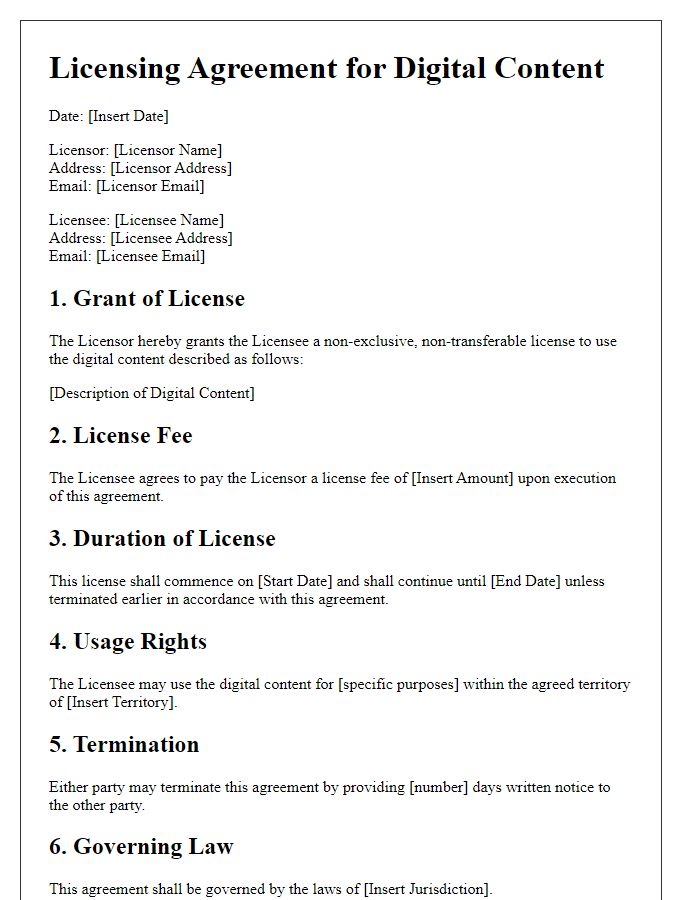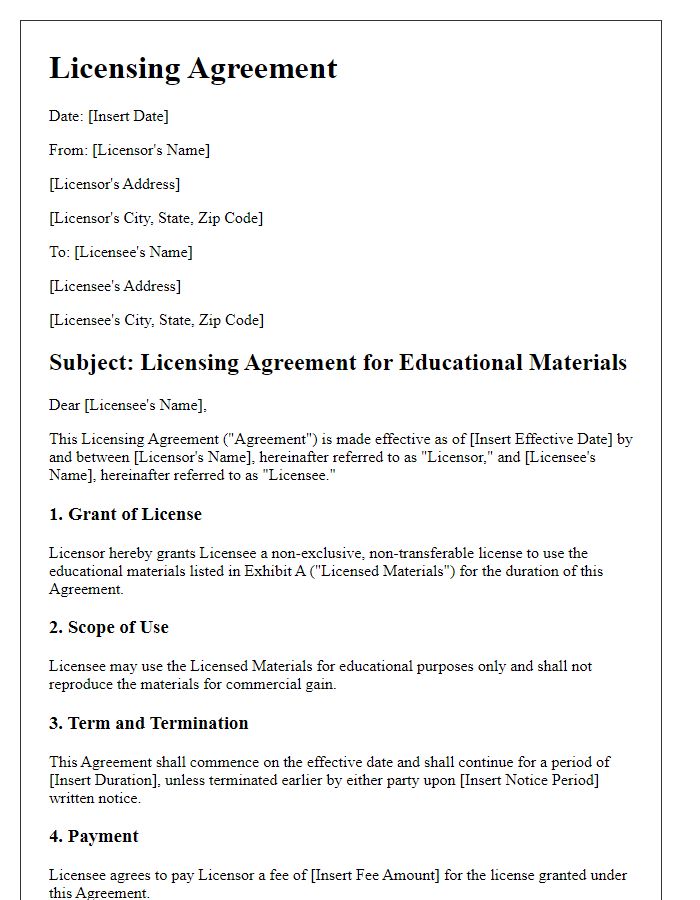Are you considering entering a licensing agreement for your business? Crafting the perfect letter is essential to ensure both parties are on the same page and that your interests are protected. In this article, we'll provide you with a comprehensive template that outlines the key components of an effective licensing agreement letter. So, grab a cup of coffee and let's dive in to help you navigate this important business decision!

Clear identification of parties involved.
A licensing agreement outlines the terms between two parties, the licensor (the party granting permission) and the licensee (the party receiving permission). Identification of the parties includes full legal names, addresses, and relevant business identifiers such as registration numbers or tax identification numbers. For instance, the licensor, "ABC Technologies LLC," is registered in New York with tax ID 12-3456789, located at 123 Innovation Drive, New York, NY 10001. The licensee, "XYZ Enterprises Inc.," has a registration number of 98-7654321, based at 456 Market Street, Los Angeles, CA 90001. Clearly identifying both entities establishes the legitimacy of the agreement and helps avoid any potential disputes regarding the validity of the partnership.
Detailed description of intellectual property.
A licensing agreement involves detailed descriptions of intellectual property (IP), which can include patents, trademarks, copyrights, and trade secrets. Patents may cover inventions like advanced robotics or pharmaceutical compounds, usually specified with unique identifiers such as patent numbers and expiration dates. Trademarks, representing brand identity, include logos and slogans protected under applicable jurisdictions, such as the United States Patent and Trademark Office (USPTO). Copyrights protect original works, including software code, artistic designs, and written content, with their registration number and date provided for reference. Trade secrets include proprietary processes or formulas vital for competitive advantage, safeguarded through non-disclosure agreements (NDAs). Each IP component should be clearly delineated in terms of scope, usage rights, and limitations to ensure legal clarity and compliance.
Specific terms and duration of the license.
A licensing agreement in business often includes specific terms such as the scope of use, territory restrictions, and duration of the license. For instance, a technology licensing agreement might state that the license is valid for five years, permitting the licensee to use proprietary software, specifically version 3.0 developed by TechCorp, within the European Union region. The terms may stipulate that the license cannot be transferred without written consent from the licensor, and any modifications to the software must be reported to TechCorp. Furthermore, the agreement could outline royalties, such as a 10% fee on gross revenues generated from products utilizing the licensed software, ensuring both parties are protected and understand the limitations and obligations related to the use of intellectual property.
Payment terms and royalties.
In a licensing agreement, payment terms and royalties often outline the financial obligations between the licensor and licensee. The licensee commits to pay an upfront fee (often in the range of thousands to millions of dollars) for the rights to use the licensed intellectual property, including patents, trademarks, or copyrighted materials. Additionally, the agreement may stipulate ongoing royalty payments, typically calculated as a percentage (usually between 3% to 15%) of gross sales generated from the licensed products or services. Payment schedules may be quarterly or annually, detailing when the licensee must report sales and remit royalties. Any late payments may incur penalties or interest, ensuring prompt adherence to financial obligations. Clear stipulations regarding audit rights should be included, allowing the licensor to verify sales figures and royalty calculations through inspections or financial reviews.
Rights and obligations of both parties.
A licensing agreement in business establishes the rights and obligations of both parties involved in the arrangement. The licensor, often a company holding intellectual property rights, grants permission to the licensee to use, distribute, or reproduce that intellectual property within agreed-upon parameters. Key obligations for the licensor may include maintaining the validity of the intellectual property, providing necessary documentation, and ensuring that the rights are not infringed upon by third parties. The licensee, on the other hand, must adhere to the terms of usage specified, such as geographical limitation, duration of the license, and quality control measures. Additionally, the licensee may be required to pay royalties or other fees based on sales volumes or milestones. The agreement typically stipulates the process for addressing breaches, renewal terms, and dispute resolution mechanisms, ensuring clarity and protection for both parties throughout the contract duration.













Comments